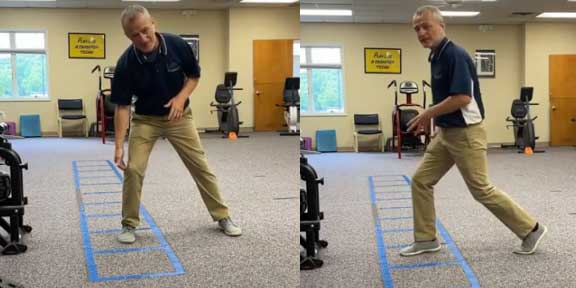These pickleball footwork drills are designed to help pickleball players move effortlessly around the court.
These drills alwo improve balance for non-pickleball players.
6 Pickleball Footwork Drills
Side Shuffle
This is the most important of the pickleball footwork drills and the best way to move laterally across the court. When a pickler is side shuffling the feet will never criss-cross as in the photo below.
To perform a right side shuffle, the pickleball player should start in a wide stance with feet wider than shoulder width apart. The first movement is the right foot/leg pulls the pickleball players body to the right.
* Note: When shuffling right, the left foot isn’t pushing the player right.
As the right leg pulls the players body right, the left foot will come off the ground and swing to the right. Once the players center of gravity is far enough to the right the right foot will leave the ground and the left foot will replace it. The right foot will then take the new position again wider than shoulder width away from the left.
This foot work (see also ‘What Is A Foot Fault?‘) can be repeated as many times as necessary to move the athlete across the court.
* Note: A great tool to work on Pickleball footwork drills is an agility ladder. I use this agility ladder in my physical therapy clinic. Click here to check availability on Amazon.
Return to the Middle
In this pickleball footword drill a player will complete one side shuffle to the left then return to the middle of the court with a side shuffle back to the right.
A variation would be to have a coach stand on the other side of the net and in a random order the coach will raise the left or right arm triggering the pickleball player to side shuffle left then return to center or side shuffle right and return to center.
This is both a reactive training exercise and a reminder to always return to a ready position.
Cross Over In Front
Stepping across your body isn’t an ideal strategy, but sometimes it is necessary. In this drill the pickler will start in a ready position and step either the right foot across the body while moving to the left, or the left foot across the body while moving to the right.
When would a cross over step be used?
The most common time to use a cross over step like this is when your bodyweight is when you are changing direction and your bodyweight is shifted toward the foot opposite of the direction you want to go.
For example, you just side shuffled to your right and now you have to quickly change direction and go left. If you can’t recenter your bodyweight you may be better to simply use your right foot to push off the ground and step it across your left.
A cross over step is often followed by a shuffle if more distance needs to be covered.
Cross Over Behind
To perform this footwork the athlete would be moving to the right and step the left foot behind the right foot before the right foot then steps to the right.
When is a cross over behind footwork used?
This footwork is most often used when you are slightly off balance and need to recover. For example, the ball is hit at you and jams you up. If you don’t have time for a pivot step, you might use the step behind to give you some space while moving laterally.

Diagonal Forward Step
This usually happens from a ready position. The player will step forward and diagonal at approximately a 45-degree angle. This could be a diagonal step or a diagonal lunge.
This footwork is used when a ball is hit faster than expected and the player is reaching farther than expected.
Diagonal Backward Step
Similar to the diagonal forward step, the diagonal backward step happens when the player steps one foot back and at a 45-degree angle to the starting position.
This footwork helps the player gain space and time to return a ball hit at the player’s body.
If you would like to see more footwork drills watch this Primetime Pickleball.


